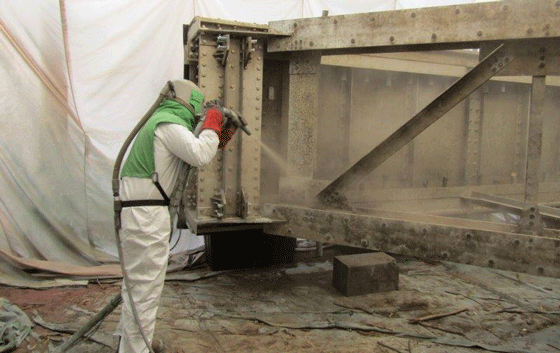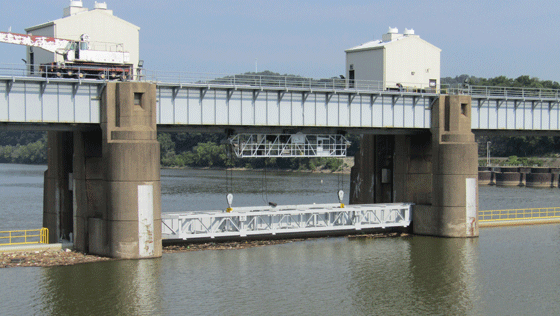Zebra mussels, a small shellfish indigenous to Russia and Ukraine, have been causing big problems in North American waters. The Emsworth Locks and Dam, located on the Ohio River in Pittsburgh, Pennsylvania, is evidence of that. Along with the Youghiogheny and Allegheny rivers, these three rivers run through the steel city, acting as gateways to the Mississippi River and beyond.
But the invasive mussels were throwing a wrench in the wicket-style (aka gate) system, and to add insult to injury, the steel plates on the aluminum structures made for two different metals — a corrosion-breeding situation. “Typically, you don’t coat aluminum because it doesn’t need it, but they [the U.S. Army Corps. of Engineers] were having problems with zebra mussels attaching themselves to the bulkhead,” said Gene Ebbinghaus, project manager at contractor Coatings Unlimited Inc.
“Secretions from the zebra mussels were causing pitting in the aluminum,” he continued. “They were concerned about losing the structural integrity. In addition to that, there was a combination of stainless steel and aluminum because the ends weighed so much. They had to have stainless steel at the ends to pick them up.”
According to Shawn Eagan, jobsite supervisor with the contractor, the bulkheads were used so that the Corps. could access areas where the water usually was when repairs were necessary. To bring the bulkheads back to speed, the Corps. called in the experts from Coatings Unlimited.
Seasoned Professionals
Eagan has worked with Coatings Unlimited for 18 years. “I’ve been a union painter for 27 years, and I’ve only worked for two companies,” he said. “I’m pretty proud of that.” The other three members of his crew — two manning the nozzles and one watching the pots — have been with the contractor for a few years, too.
“They are skilled professionals,” Eagan explained. “I could say the world about my guys. They’re the workhorses.”
In addition to the crew, the Corps. was a familiar face on this project. “It wasn’t the first time we’d worked with them, so they had us come back instead of having someone else in their area do the work, which means a lot to us that we were even invited to bid on work like that,” Eagan said.
The crew worked on one of the four bulkheads at a time, starting with installing two types of containment. They used 85 percent containment underneath to avoid putting any remaining mussels back into the water. And they used 100 percent (aka impenetrable) tarps when prepping, which they were able to recycle for another job after this one ended since it didn’t involve any lead.

That prep included pressure washing the aluminum with 5,000 psi (34.5 MPa) to ensure there were no remaining contaminants, such as algae. “Whatever came off, we would collect,” Eagan explained. “We filtered the water that went through the 100 percent tarps before we let it run back into the river. We used non-potable water to wash — we didn’t use river water — and then disposed of anything that came off into regular nonhazardous dumpsters.”
To prep for the coatings, the crew needed to achieve a 1.5-mil (38.1 microns) blast profile via Society for Protective Coatings (SSPC) Surface Profile (SP) 16: Brush-off Blast Cleaning Non-Ferrous Metals. They used a Sullair 750 air compressor, a Schmidt blast pot, 80-grit garnet, #6 nozzles, and two crew members. “One guy started in the middle and worked toward the river, and the other guy started at the far end working towards the middle,” Eagan said. The crew wore heavy-duty rain suits and boots with metatarsal guards during the prep.
To Humidity and Beyond
Despite the containment coverage, the crew still had to work around a weather-related issue. The humidity on the water was “a pain,” according to Eagan. “A lot of times we couldn’t start first thing in morning; there’d be fog and issues.” They’d wait until the humidity dropped to start working, using a dew point meter (DPM) from DeFelsko to measure the ambient conditions and fans to circulate the air inside the containment.
Once they were able to coat, the crew patched any corrosive pits created by the dissimilar metals using Belzona 1311. That ceramic epoxy-based composite material was applied with spatulas at an average of ½-inch (1.3 cm) thickness and cured overnight. Then, the crew came back in to work on the three-coat system: MIL DTL 244441 Type IV at an average of 7 wet mils (177.8 microns) and 5 dry mils (127.0 microns); MIL DTL 244441D Type III at an average of 5 wet mils (127.0 microns) and 3 dry mils (76.2 microns); and ProLine 4800 at an average of 3 wet mils (76.2 microns) and 2 dry mils (50.8 microns). Those coatings, from Sherwin-Williams, were spray-applied using Graco bulldog pumps.
“We put the type 4 on first then the type 3. It’s not easy, it’s never easy,” Eagan joked of the inverted numbers. They’d sand and recoat any minor defects, and the Corps. was sure to verify measurements in between each coat as well as after the blasting.
“They don’t have to see everything we do, but because we were so close to their headquarters, they were interested in what we were doing,” Eagan explained. The crew tested the wet film thicknesses along the way with a gage and then the dry film thicknesses later with a Positector 6000 from DeFelsko.
As for safety, the crew wore Nova supplied-air hoods when blasting and 3M respirators when painting in addition to harnesses from Miller, chokers, and retractable lanyards when working at heights. The 100 percent tie off was particularly important when erecting the containment, since the crew was using the bulkheads alone for reaching heights. But even after that point, they still needed scaffolds to work. “Most of the work was only 8 feet [2.4 m] off the ground, but we ran a static line to attach to when we were working above it,” Eagan said. Finally, they had 15 air exchanges per hour using 6,000 CFM (169.9 m3/min.) dust collectors.
Positive Outcomes
In total, the crew covered 40,000 square feet (3,716.1 m2) of aluminum. According to Eagan, the client was happy with the work, and they certainly must have been happy with how it was accomplished. “We got it done within our schedule and under budget,” he proclaimed. It helped to have a seasoned crew, involved client, and other team members, such as Alltech Engineering working on the removal and installation of the bulkheads’ rollers, swimming together to get the job done.
As for Eagan, who hails from St. Louis, Missouri, his time in Pittsburgh was a memorable one. “The civic pride in Pittsburgh doesn’t compare to anything I’ve ever seen in my life,” he said. “If I could live anywhere besides where I live, I’d live in Pittsburgh. I love it. I feel in love with the town. It’s a neat, neat place.”
